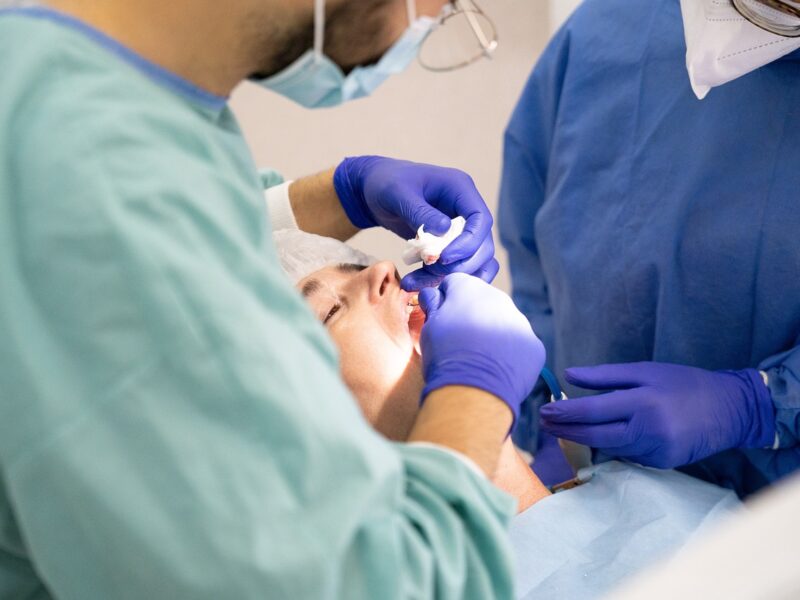Root Canal Complications: What Can Go Wrong and How We Prevent It
Root canal complications are not very common, but they may happen—and when they do, there’s usually a reason. In most cases, it comes down to how the treatment is planned and carried out. Small details matter.
Today, our Brisbane Dentists explain what can go wrong during a root canal, how those problems are usually avoided, and what we do to keep things on track. If you’re curious about the risks or just want to know what a well-done root canal looks like behind the scenes, you’re in the right place.
What Is a Root Canal?
A root canal is a dental procedure used to clean out infection from inside a tooth. It involves removing the damaged nerve and soft tissue (called pulp), cleaning the root canals, and sealing them so bacteria can’t get back in. Root canal complications can happen if any part of that process isn’t done properly—like missing a canal, not cleaning it fully, or sealing it too short or too far. That said, when the procedure is done with care and precision, root canal complications are rare, and the tooth can last for many years without trouble.

How We Prevent Root Canal Complications
Here’s how complications are avoided and managed at our clinic:
Accurate Diagnosis Comes First
We start by asking questions about your symptoms, medical history, and previous dental work. Then we do tests to check how the tooth responds to things like cold or pressure. X-rays help us see the inside of the tooth and the surrounding bone. This step is crucial to make sure we’re treating the right tooth and not missing anything.
The Role of Rubber Dam Isolation
During a root canal, we use a rubber sheet to cover the rest of your mouth and isolate the tooth. This stops saliva and bacteria from getting into the area we’re working on. It also keeps the area clean and dry, which helps the treatment succeed. A snug clamp holds it in place, and any small leaks are sealed right away.
Conserving Tooth Structure
We avoid removing more of the tooth than necessary. The smaller the hole we make, the stronger the tooth stays after the treatment. We shape the inside of the tooth just enough to clean it properly. Keeping as much natural tooth structure as possible helps prevent cracks or future damage.
Sterile Technique and Modern Equipment
Our dentists use sterile tools and single-use items to avoid cross-contamination. Our equipment allows for the precise cleaning and shaping of the root canals. We also use powerful disinfectants to remove bacteria. All of this reduces the risk of infection or treatment failure.
Managing Common Root Canal Challenges
Sometimes, even with careful planning and technique, certain issues may still come up during or after a root canal. Here’s how our dental experts manage the most common ones in a safe and predictable way:
Pain Management
What Causes Pain During or After Treatment
Mild pain or tenderness is normal for a day or two after treatment. It’s usually caused by inflammation or pressure around the tooth as it heals.
How We Prevent It
We clean the root canals properly, use strong disinfectants, and seal the tooth well to stop bacteria from staying inside. Pain is also reduced by removing infected tissue early and using gentle techniques.
What We Do If You’re in Pain
Over-the-counter pain relief like ibuprofen usually works well. If pain continues or worsens, we’ll check the tooth again, clean the canals if needed, and place medication inside to calm the area.
Cracked Teeth
How Cracks Affect Root Canal Success
Cracks can let bacteria into the tooth, making it harder to clean and seal properly. If the crack runs too deep, the tooth may not be savable.
Early Intervention Strategies
If dentistst catch the crack early, they may do a pulpotomy to keep the nerve alive, especially in young teeth. In more serious cases, they remove the damaged tissue and do a full root canal to protect the tooth from further damage.

Local Anaesthetic-Related Issues
Anaesthetic is a key part of any root canal procedure, and while it usually works well, there are a few rare problems that can come up:
Broken Needle (Rare but Possible)
How We Avoid It
Needle breakage is extremely rare, but our dentists reduce the risk by never bending the needle and avoiding inserting it all the way to the hub. They also choose the right needle length and thickness for each injection. Patient movement during the injection is kept to a minimum to prevent unnecessary stress on the needle.
What Happens If It Occurs
If a needle tip does break and we can see it, we remove it immediately with special instruments. If the fragment is not visible, we refer you to an oral surgeon to safely retrieve it, as leaving it can cause further problems. Such cases are so uncommon that most dentists never encounter them in their entire career.
Post-Injection Soreness or Limited Jaw Movement (Trismus)
Why It Can Happen
Trismus can happen when the jaw muscles are irritated during the injection or when several injections are required in a single area. It’s often temporary and may simply feel like a stiff jaw.
How We Treat It
Anti-inflammatory medicines such as ibuprofen help reduce swelling and discomfort. Warm compresses and gentle jaw exercises can speed up recovery, and muscle relaxants may be used if needed. If an infection is suspected, we add antibiotics to the treatment plan.
Anaesthesia That Doesn’t Work Properly
What Causes It
Sometimes the anaesthetic doesn’t fully block the nerve due to inflammation around the tooth or unusual nerve anatomy. This can make the tooth harder to numb, especially in cases of severe infection.
What We Do Differently
Dental professionals use advanced techniques such as Gow-Gates or intraosseous injections to target the nerve more accurately. They may also use additional anaesthetics in different spots to ensure full comfort during the procedure. Dentists’ approach is tailored to your tooth’s position and condition, so the anaesthetic works as intended.
Numbness That Lasts Too Long (Paresthesia)
How We Minimise the Risk
Paresthesia happens when a nerve is irritated during the injection, which is rare. We lower the risk by using the right type and concentration of anaesthetic and carefully placing the injection to avoid direct nerve contact.
When to Follow Up
Most cases of prolonged numbness resolve naturally within a few weeks. If the numbness persists beyond eight weeks, we will investigate further with imaging, such as a CBCT scan, and refer you to a specialist if necessary.
Anaesthetic Spreading to the Wrong Area
Unintended Effects (e.g., Eye or Face Numbness)
Occasionally, anaesthetic can spread to nearby nerves, causing temporary effects like a drooping eyelid or tingling in the face. While unusual, this effect is temporary and usually resolves within hours.
Our Protocols for Managing It
If the eye is affected, dental experts keep it protected with lubricants or a light shield until sensation returns. They monitor you closely and explain what’s happening, ensuring you’re comfortable and safe throughout.
Bruising or Hematoma
Why It Happens
A small bruise can appear if a blood vessel is accidentally nicked during the injection. This is more likely in areas with many blood vessels or if you take blood-thinning medication.
Simple Ways to Manage It
We apply firm pressure immediately and use a cold compress to prevent the bruise from spreading. After 24 hours, warm compresses help improve blood flow and clear the mark faster.
Rare Reactions or Overdose
Safe Dosing Practices We Follow
Our dentists carefully calculate the exact amount of anaesthetic based on your age, weight, and health to prevent overdose. Aspiration techniques ensure we avoid injecting directly into blood vessels.
What to Do If You Feel Unwell
If you experience dizziness, ringing in your ears, or confusion, we stop immediately, give you oxygen, and stabilise your breathing. Emergency help is called if the reaction doesn’t resolve quickly.
Biting Injuries After Anaesthetic
Tips to Protect Lips, Cheeks, and Tongue
When your mouth is numb, it’s easy to bite your lip or cheek without realising. We recommend avoiding chewing until the feeling returns and placing soft gauze between your teeth if needed.
What to Do If It Happens
Most small injuries heal on their own within a few days. Keep the area clean, rinse with salt water, and use pain relief if needed to ease discomfort.
Technical Root Canal Complications and How We Handle Them
Root canal procedures involve precise cleaning, shaping, and sealing of tiny internal structures. Because the space inside a tooth is so complex, certain technical problems can occur if treatment isn’t done carefully. At our clinic, we use advanced imaging, fine instruments, and well-tested protocols to prevent or fix these complications as soon as they appear:
Missed Canals
How We Find Hidden Canals with 3D Imaging
Teeth often have more canals than expected—especially molars, which can hide an extra one behind the others. If a canal is missed, bacteria can remain inside and lead to failure later on. We use 3D imaging (like cone beam CT scans) to map out the root system before and during treatment. This lets us locate and clean every canal, including the tricky ones that don’t show up on regular X-rays.
Measuring and Cleaning the Full Root
Why Length Accuracy Matters
To fully clean and seal a canal, we need to know exactly how deep it goes. Stopping too short can leave infection behind, while going too far can damage the surrounding tissue. Even being off by 1 mm makes a difference in success or failure.
What We Use to Get It Right
Our dentists combine digital X-rays, an electronic apex locator, and precise files to measure canal length during the procedure. This helps them clean all the way to the natural end of the root without going past it. They also re-check measurements before sealing the tooth.
Instrument Breakage
How File Separation Happens
The small metal files used to clean root canals can sometimes break inside the tooth, especially if they’re used with too much force or in narrow, curved canals. This is known as file separation. It’s usually caused by metal fatigue or overuse.
Whether It Affects Treatment
In most cases, the broken piece doesn’t cause problems if the canal has already been disinfected. We either work around the fragment or remove it using special tools under a microscope. We always inform you if this occurs and explain the options clearly.
Cleaning, Shaping, and Sealing Challenges
Avoiding Canal Blockages and Perforations
Canals can sometimes get blocked by debris or shaped incorrectly, which might cause a ledge or even a hole in the side of the root (perforation). We prevent this by using small, flexible hand files first, and never forcing them. Careful irrigation helps flush out debris and keeps the path open.
Preventing Overfilling or Underfilling
Filling material must go right to the end of the root and no further. We prevent overfilling by confirming the length of the canal multiple times before sealing it. Underfilling is avoided by shaping the canal evenly and choosing the correct size for the final filling material.
How We Handle “Hypochlorite Accidents”
If cleaning fluid (sodium hypochlorite) accidentally leaks past the root tip, it can cause swelling or burning pain. We reduce this risk by using side-vented irrigation needles, applying light pressure, and constantly moving the needle. If it does happen, we manage it with cold compresses, anti-inflammatory medication, and close monitoring.
Temporary Fillings and Microleaks
The Importance of Good Temporisation
Between appointments, our dental experts place a temporary filling to seal off the canals and protect against bacteria. If the seal breaks down or is poorly placed, saliva and microbes can leak back in—this is known as coronal microleakage. Even a small leak can compromise the whole treatment.
When Retreatment Might Be Needed
If the filling is lost or the root filling is exposed for more than a few days, we usually recommend retreatment to prevent infection. To reduce this risk, we use high-quality temporary materials and apply non-setting calcium hydroxide inside the canal for extra protection.
What Happens After the Root Canal
Once the root canal treatment is finished, the focus shifts to healing, protecting the tooth, and preventing future issues. What happens next plays a big role in how long the tooth lasts and whether any complications arise:
Flare-ups After Treatment
What They Are
A flare-up is when the tooth becomes sore or swollen shortly after the root canal is done. It’s usually caused by inflammation in the surrounding tissue, especially if the area was already infected or irritated before treatment. While it can be uncomfortable, it’s not a sign of treatment failure.
How We Ease Discomfort
We usually recommend anti-inflammatory medication like ibuprofen to reduce pain and swelling. Most flare-ups settle within a few days to a week. If the pain gets worse or doesn’t improve, our dentists may need to check and clean the canals again or prescribe further treatment.
Final Restoration
Why the Crown or Onlay Matters
After a root canal, the tooth becomes more brittle because the nerve and blood supply have been removed. To protect it from cracking or breaking, we usually cover it with a crown or onlay. This acts like a helmet, absorbing pressure from chewing and keeping the tooth stable.
When Posts Are (and Aren’t) Needed
We only use a post if there isn’t enough natural tooth left to hold the crown securely. While posts help with retention, they can increase the risk of fracture if not done properly. Whenever possible, we design the restoration to avoid needing a post at all.
Tooth Fracture After Treatment
How We Reduce That Risk
Root canal-treated teeth, especially back teeth, are more likely to crack if they’re not reinforced. Our dentists usually reduce this risk by placing strong, well-fitted restorations as soon as possible after the treatment. Keeping as much natural tooth structure as we can during the procedure also helps protect against fractures.
Why Material Choice and Design Matter
We choose materials that match the tooth’s function—stronger ones for molars, more aesthetic ones for front teeth. Onlays are often preferred over full crowns because they’re less invasive but still offer great protection. The shape and design of the restoration also help distribute bite forces evenly, reducing stress on the tooth.

Special Cases
While root canal treatment is generally predictable, some medical conditions or unique tooth responses can make things a bit more complicated. In these situations, we adjust the way we plan and perform treatment to keep risks low and outcomes stable:
Patients With Medical Conditions
Diabetes, Bleeding Disorders, and Medications
Patients with diabetes may heal more slowly and experience more post-treatment symptoms, especially if blood sugar is poorly controlled. Bleeding disorders, blood thinners, or conditions like haemophilia increase the risk of bleeding during treatment. Some medications, like high-dose bisphosphonates or cancer therapies, can affect how bone and tissue respond to dental work. Before treatment, we review your medical history in detail and may sometimes get in touch with your GP or specialist if any adjustments are needed.
Our Approach to Higher-Risk Patients
We take extra care when placing rubber dam clamps or performing injections to avoid unnecessary trauma in medically compromised patients. In some cases, we may use gentler techniques or modify the procedure timeline to reduce stress on the body. Age alone isn’t a concern, but older teeth may have more calcification, which we plan for during treatment.
When Healing Doesn’t Happen
Signs of Persistent Infection
Even after treatment, some teeth may continue to feel tender or show signs of infection on X-rays. This could mean bacteria are still present in hidden or untreated areas of the root system. Common signs include ongoing pain, swelling, or a dark area on an X-ray that doesn’t shrink over time.
Retreatment or Root-End Surgery Options
If healing stalls, we often recommend nonsurgical retreatment, where we reopen the tooth, clean it more thoroughly, and seal it again. If this isn’t possible or doesn’t work, a minor surgical option called root-end surgery (apicoectomy) may be considered to remove the infected tip directly. Both approaches aim to save the tooth and eliminate any lingering infection. Regular follow-up x-rays help us track healing and decide on the next step early if needed.

Final Thoughts
Modern Root Canals Are Safe and Predictable
When done properly, root canal treatment has a high success rate and can save a tooth for many years. Advances in imaging, tools, and techniques have made the process much more accurate and comfortable than it used to be. Like any medical procedure, it’s not entirely risk-free, but serious problems are uncommon when the work is done carefully.
Our Focus Is Always on Prevention
Preventing complications starts well before the first appointment and continues through every step of treatment. From diagnosis and isolation to final restoration, small details make a big difference. A methodical, patient-centred approach helps us avoid unnecessary risks and achieve better long-term outcomes.
When to Get in Touch If You Have Concerns
If something doesn’t feel right after a root canal—or even months later—it’s always worth checking in. Pain, swelling, or changes in how the tooth feels could mean something needs attention. Early review and imaging can prevent bigger problems down the track. We’d rather hear from you too soon than too late.
Too Anxious for a Root Canal? Here’s How We Make It Easier
For patients who are afraid of dental procedures, we offer sedation dentistry options to make treatment more manageable and less stressful:
Laughing Gas (Nitrous Oxide)
Laughing gas is a mild sedative inhaled through a mask. It helps you stay calm while remaining fully awake, and it wears off quickly after the procedure.
IV Sedation
IV sedation is a conscious sedation type and is delivered through a small vein in your arm. This sedation option is also sometimes referred to as twilight sedation and puts you into a dream-like state. You’re conscious but disconnected from what’s happening and unlikely to remember much.
Sleep Dentistry
For patients with severe dental fear, special needs, or those requiring longer procedures, Sleep Dentistry in Brisbane under general anaesthesia is the deepest level of sedation we offer. You’ll be completely unconscious and won’t remember anything from the procedure.
According to Brisbane Dental Sleep Clinic, Sleep Dentistry Brisbane helps reduce the tension some patients may feel during dental procedures.

Think Your Root Canal Failed? We Can Help!
If your root canal isn’t healing right—or something just feels off—it’s worth a second look. We’ll find out what’s going on and what can be done. Reach out to us by calling: 07 3343 4869.